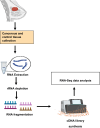This is a preprint.
The Association between the JAK-STAT Pathway and Hypertension among Kenyan Women Diagnosed with Breast Cancer
- PMID: 38895458
- PMCID: PMC11185763
- DOI: 10.1101/2024.06.07.597892
The Association between the JAK-STAT Pathway and Hypertension among Kenyan Women Diagnosed with Breast Cancer
Abstract
Background: Breast cancer is the most common malignant tumor in women worldwide, and disproportionately affects Sub-Saharan Africa compared to high income countries. The global disease burden is growing, with Sub-Saharan Africa reporting majority of the cases. In Kenya, breast cancer is the most commonly diagnosed cancer, with an annual incidence of 7,243 new cases in 2022, representing 25.5% of all reported cancers in women. Evidence suggests that women receiving breast cancer treatment are at a greater risk of developing hypertension than women without breast cancer. Hypertension prevalence has been on the rise in SSA, with poor detection, treatment and control. The JAK-STAT signaling is activated in hormone receptor-positive breast tumors, leading to inflammation, cell proliferation, and treatment resistance in cancer cells. We sought to understand the association between the expression of JAK-STAT Pathway genes and hypertension among Kenyan women diagnosed with breast cancer.
Methods: Breast tumor and non-tumor tissues were acquired from patients with a pathologic diagnosis of invasive breast carcinoma. RNA was extracted from fresh frozen tumor and adjacent normal tissue samples of 23 participants who had at least 50% tumor after pathological examination, as well as their corresponding adjacent normal samples. Differentially expressed JAK-STAT genes between tumor and normal breast tissues were assessed using the DESEq2 R package. Pearson correlation was used to assess the correlation between differentially expressed JAK-STAT genes and participants' blood pressure, heart rate, and body mass index (BMI).
Results: 11,868 genes were differentially expressed between breast tumor and non-tumor tissues. Eight JAK-STAT genes were significantly dysregulated (Log2FC ≥ 1.0 and an Padj ≤ 0.05), with two genes (CISH and SCNN1A) being upregulated. Six genes (TGFBR2, STAT5A, STAT5B, TGFRB3, SMAD9, and SOCS2) were downregulated. We identified STAT5A and SOCS2 genes to be significantly correlated with elevated systolic pressure and heart rate, respectively.
Conclusions: Our study provides insights underlying the molecular mechanisms of hypertension among Kenyan women diagnosed with breast cancer. Understanding these mechanisms may help develop targeted treatments that may improve health outcomes of Kenyan women diagnosed with breast cancer. Longitudinal studies with larger cohorts will be needed to validate our results.
Conflict of interest statement
Disclosure of conflict of interest None
Figures





References
Publication types
Grants and funding
LinkOut - more resources
Full Text Sources
Research Materials
Miscellaneous
